Best Editorial Calendar Apps for 2025
Discover top editorial calendar apps to streamline your content planning and social media scheduling in 2025.
Posted by
Level Up Your Content Game with a Powerful Editorial Calendar
Struggling to stay organized and consistent with your content? Stop juggling spreadsheets and sticky notes. This listicle presents 10 top-tier editorial calendar apps to streamline your content workflow. Discover which of these tools—including CoSchedule, Trello, Asana, Airtable, Monday.com, Notion, ContentCal (now Bynder), ClickUp, Buffer, and Loomly—best suits your needs and budget. Learn how these editorial calendar apps can transform your content planning, scheduling, and publishing process, saving you time and boosting your content marketing results.
1. CoSchedule
CoSchedule is a robust editorial calendar app that goes beyond basic scheduling. It positions itself as an all-in-one marketing platform, bringing together project management, content planning, and social media management into a single, centralized hub. This makes it a powerful tool for teams who need to orchestrate complex marketing campaigns across multiple channels. If your editorial calendar needs extend beyond simply scheduling blog posts and you're looking for a tool to manage the entire content lifecycle, CoSchedule is worth considering. It helps streamline workflows, ensuring everyone stays on the same page and that all marketing activities are aligned with overall business objectives. For example, a small business owner could plan a product launch campaign, scheduling blog posts, social media updates, email newsletters, and even assigning tasks to team members, all within CoSchedule.
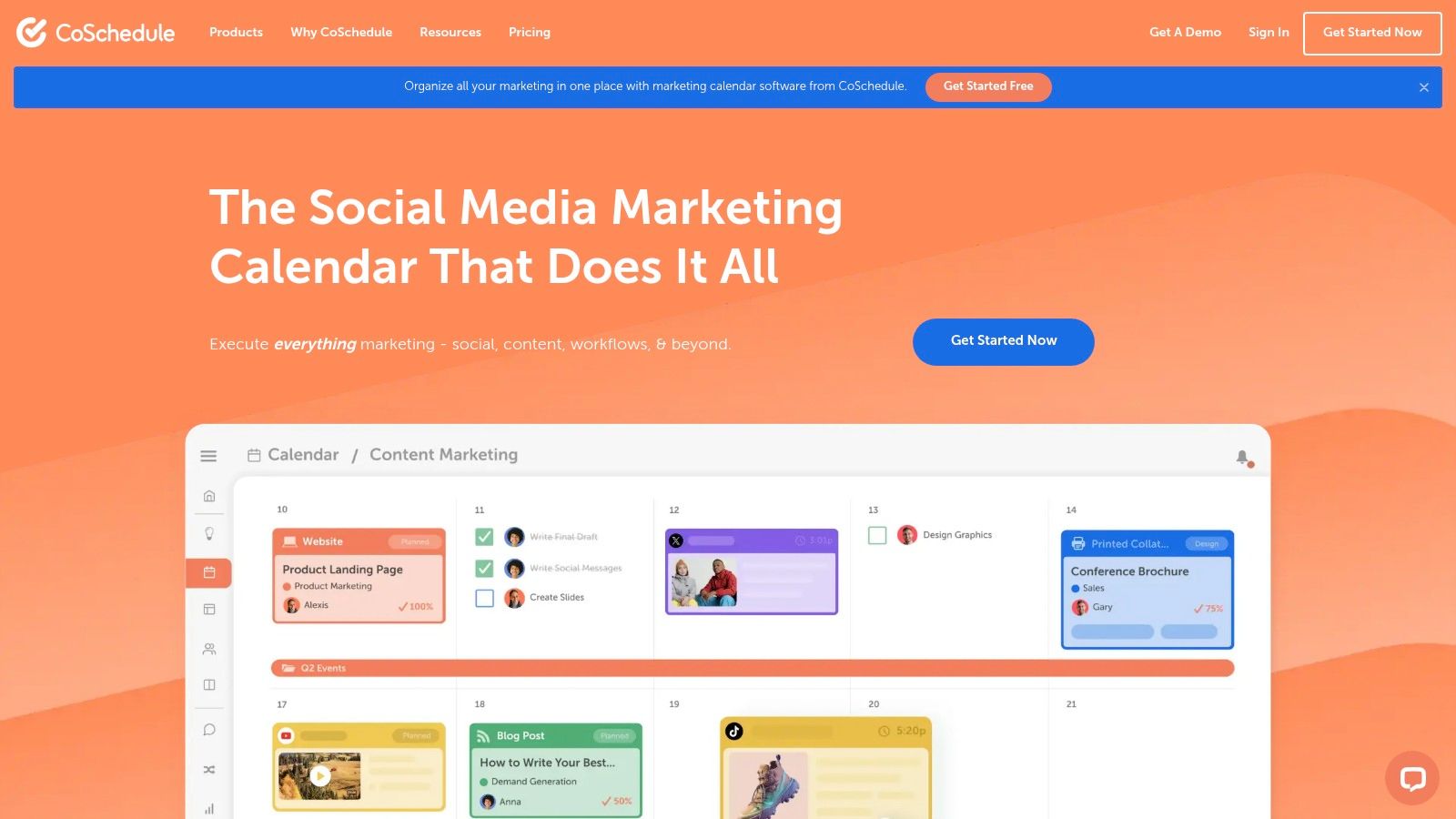
CoSchedule's key strength lies in its comprehensive nature and visual interface. The drag-and-drop calendar allows for effortless rescheduling and provides a clear overview of all planned content. Direct integration with WordPress allows users to draft, schedule, and publish blog posts directly from the platform. Social media scheduling and automation features further streamline content distribution, while integrated task management facilitates team collaboration. Beyond scheduling, CoSchedule also offers content optimization suggestions and analytics to help maximize the impact of your content. You can even learn more about CoSchedule and its social media calendar functionalities.
The platform excels in its integration capabilities, connecting seamlessly with popular marketing tools like WordPress, Google Analytics, and various social media platforms. Its ReQueue feature is a notable asset, intelligently resharing high-performing content to maximize reach and engagement without manual intervention. This is particularly beneficial for busy social media managers and digital marketers striving to maintain a consistent online presence. Creative agencies, managing multiple client accounts, can leverage CoSchedule to organize diverse campaigns and streamline client communication.
While CoSchedule offers a powerful suite of features, it’s important to be aware of its potential drawbacks. The platform comes with a higher price tag than some other editorial calendar apps, which might be a barrier for smaller businesses or individuals with limited budgets. Additionally, new users might experience a learning curve due to the platform's extensive functionality. Some users have also reported occasional bugs with certain integrations, though CoSchedule is actively working on improving and expanding its platform.
Key Features: Marketing calendar with drag-and-drop interface, WordPress integration for direct publishing, Social media scheduling and automation, Task management and team collaboration tools, Content optimization suggestions and analytics, ReQueue for automated content resharing.
Pros: Comprehensive marketing platform, Visual interface, Excellent integrations, Intelligent ReQueue feature.
Cons: Higher price point, Learning curve, Occasional integration bugs.
Website: https://coschedule.com/
Implementation Tip: Start by integrating CoSchedule with your existing marketing tools, particularly your WordPress website and social media channels. Focus on mastering the core calendar and scheduling features before exploring the more advanced functionalities. This phased approach will help you gradually acclimate to the platform and maximize its value.
2. Trello
Trello, a versatile project management tool, has found a home among content teams as a surprisingly effective editorial calendar app. While not specifically designed for editorial calendars, its flexible Kanban-style system allows for easy adaptation to content planning workflows. Teams can visualize their content pipeline using boards, lists, and cards, making it simple to assign tasks, set deadlines, track progress, and manage the entire content lifecycle. This adaptability is why Trello deserves a spot on this list, offering a robust, visual solution for those seeking a free or low-cost option.
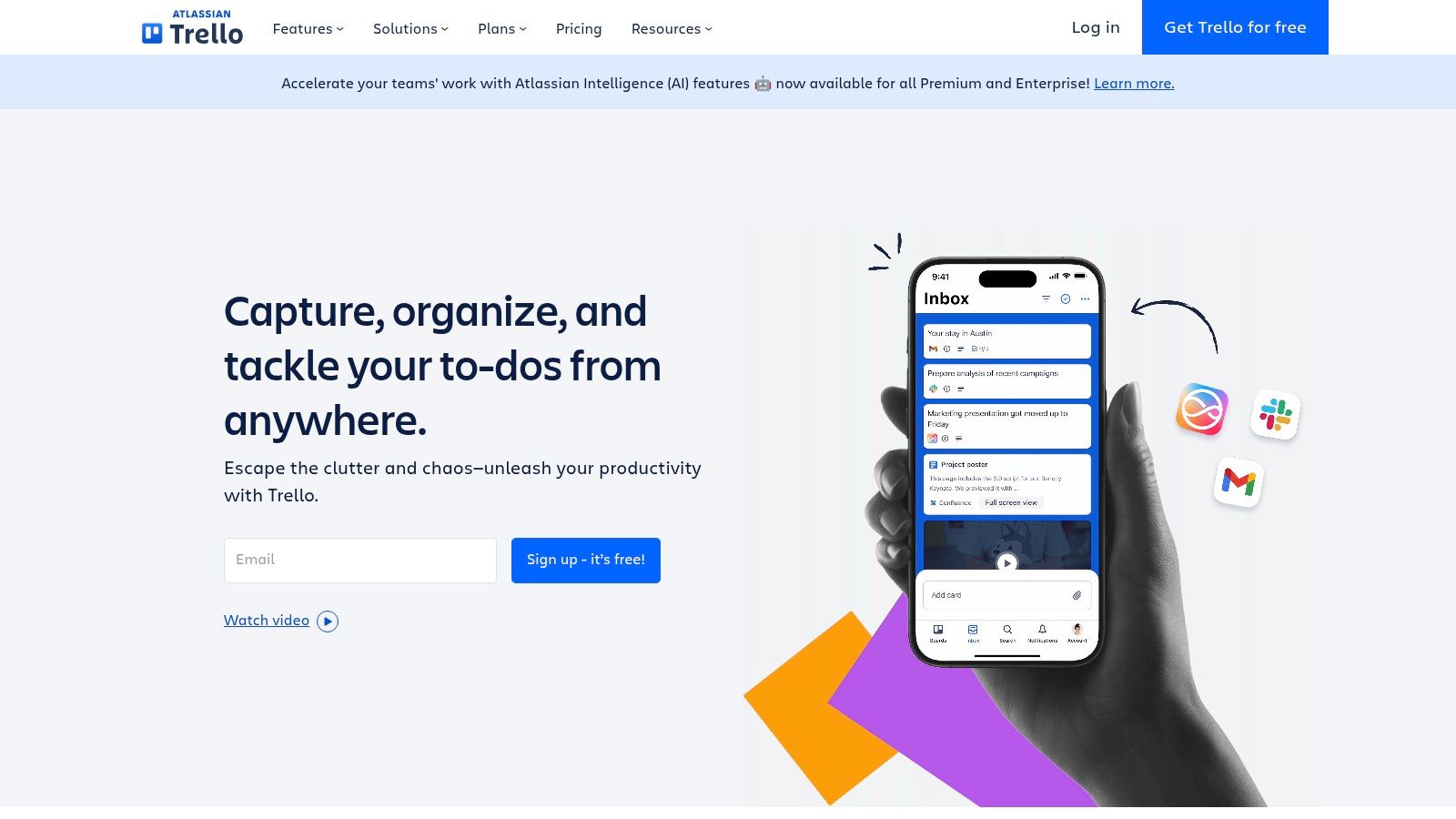
Trello's strength lies in its visual interface and customizability. Each "board" can represent a different content category (e.g., blog posts, social media, email newsletters), while "lists" can represent stages in the content workflow (e.g., Idea, Drafting, Editing, Publishing, Promotion). Individual "cards" then represent specific content pieces, complete with checklists, due dates, attachments, and assigned team members. This Kanban-style approach provides a clear overview of the content pipeline, making bottlenecks and progress easily identifiable.
For teams needing more specialized editorial calendar features, Trello's "Power-Ups" offer integrations with calendar views, Google Drive, Slack, and other tools. This extends Trello’s functionality, bringing it closer to dedicated editorial calendar apps. For example, the Calendar Power-Up allows you to visualize your content schedule in a traditional calendar format, while the Google Drive Power-Up allows you to directly link and access content drafts.
Features & Benefits:
- Kanban-style boards: Visualize your content workflow from ideation to publication.
- Customizable cards: Attach files, create checklists, assign due dates, and add detailed descriptions for each content piece.
- Power-Ups: Extend functionality with calendar views, social media integrations, and more.
- Team collaboration: Facilitate seamless communication with commenting and @mentions.
- Automation capabilities with Butler: Automate repetitive tasks like card movement and notifications.
Pros:
- Highly visual interface: Intuitive and easy to learn, even for non-technical users.
- Flexible system: Adaptable to various content workflows and team sizes.
- Free tier available: Provides ample functionality for small teams and individuals.
- Mobile apps: Manage your editorial calendar on the go.
Cons:
- Not specifically designed for editorial calendars: Lacks some specialized features found in dedicated apps.
- Can become cluttered: Managing high-volume content operations can become challenging.
- Some advanced features require paid plans: Power-Ups and Butler automation can incur additional costs.
Pricing: Trello offers a free plan with limitations on boards, Power-Ups, and team size. Paid plans start at around $5 per user per month and unlock advanced features like unlimited boards, Power-Ups, and Butler automation.
Technical Requirements: Trello is a web-based application accessible through any modern browser. Mobile apps are available for iOS and Android devices.
Implementation Tips:
- Start with a simple board structure and gradually add complexity as needed.
- Utilize labels and custom fields to categorize and filter content.
- Explore Power-Ups to enhance functionality and integrate with other tools.
- Establish clear workflows and processes for content creation and approval.
Website: https://trello.com/
Trello provides a powerful, visual, and cost-effective solution for teams seeking a flexible editorial calendar app. While it might not offer all the bells and whistles of dedicated platforms, its adaptability and free tier make it an excellent starting point for small businesses, digital marketers, and social media managers looking to organize their content efforts. For those already utilizing Trello for project management, integrating content planning into the existing system can streamline workflows and improve overall team efficiency.
3. Asana
Asana is a robust work management platform well-suited for teams needing a powerful editorial calendar app. More than just a simple calendar, Asana allows content teams to meticulously plan, organize, and track their content from initial brainstorming through publication and beyond. Its versatility shines through multiple project views, including list, board, timeline, and calendar formats, enabling you to visualize your content schedule from various perspectives and adapt to your team’s preferred workflow. This adaptability makes Asana a strong contender among other editorial calendar apps, especially for complex projects and larger teams.
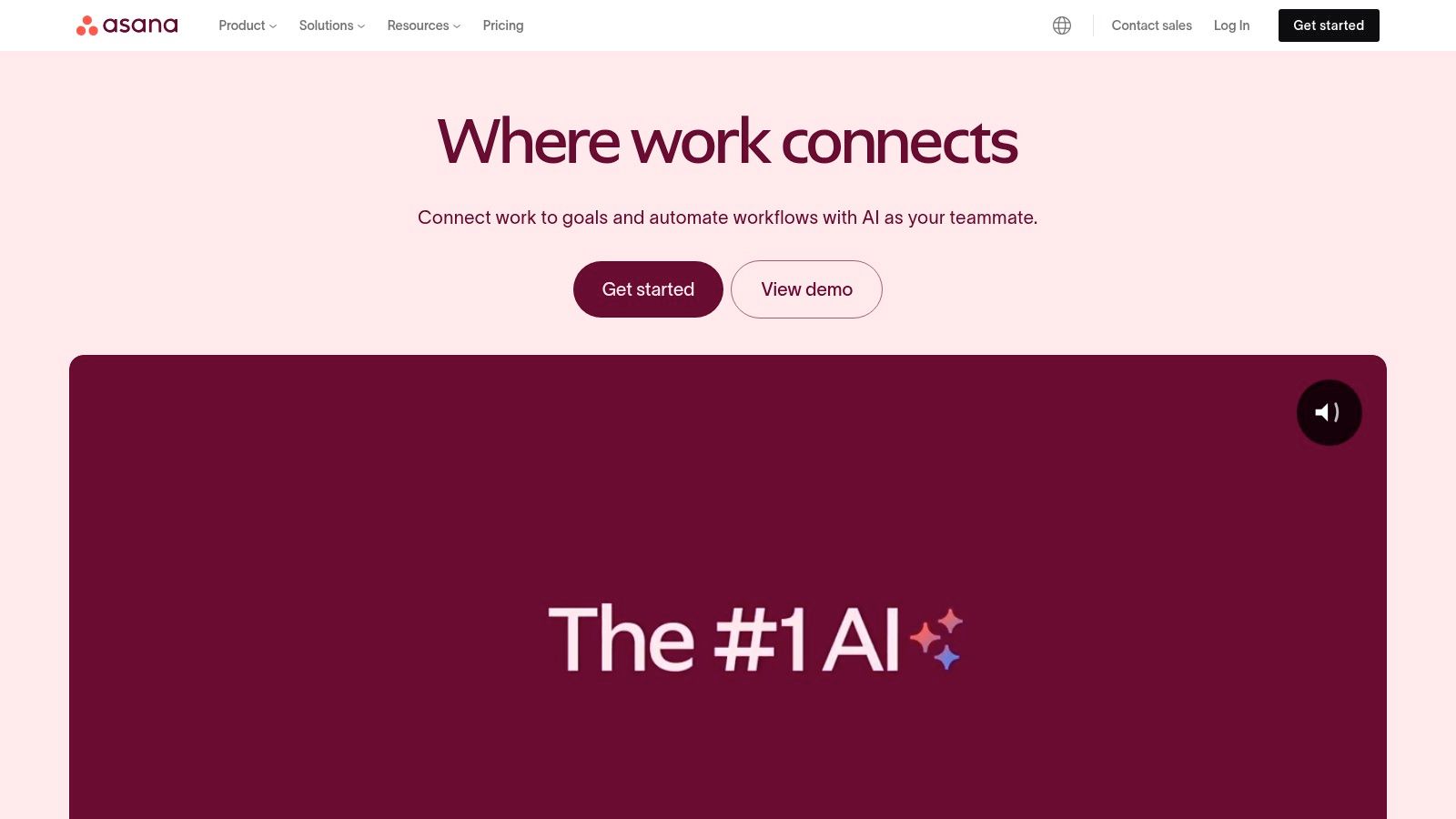
Asana's strength lies in its ability to manage intricate content workflows. Features like custom fields allow you to track content status (e.g., "In Draft," "In Review," "Published"), content type (e.g., "Blog Post," "Infographic," "Video"), and other relevant attributes. This granular control keeps everyone on the same page and minimizes confusion, particularly valuable for digital marketers, creative agencies, and customer success teams creating diverse content. Workflow automation further streamlines repetitive tasks, freeing up time for more strategic work. For complex content projects, Asana's dependencies and milestones features help map out interconnected tasks and track progress toward key deadlines. Robust search and reporting capabilities provide valuable insights into content performance and team productivity. Small business owners can leverage these features to manage their content strategy effectively, even with limited resources. You can learn more about Asana and its potential applications for content creation.
For social media managers, Asana can be a powerful tool to schedule and track posts across multiple platforms. While Asana isn't a dedicated social media scheduling tool, its integration capabilities and flexible project views can be adapted for this purpose. You can use custom fields to specify platforms, track engagement metrics, and manage approval workflows for social media content.
While Asana offers a free plan, its full functionality, including timeline view and advanced reporting, requires a paid subscription. Pricing varies depending on the chosen plan and the number of users. A potential drawback is that Asana's extensive feature set can feel overwhelming for small teams or those with simpler content calendars. There's a steeper learning curve compared to some alternatives, so factor in some training time for your team.
Key Features:
- Multiple project views (list, board, timeline, calendar)
- Custom fields for tracking content attributes
- Workflow automation
- Dependencies and milestones
- Robust search and reporting
Pros:
- Powerful organizational capabilities
- Strong team collaboration features
- Timeline view for long-term strategy visualization
- Extensive integration options
Cons:
- Can be overwhelming for small teams/simple needs
- Full functionality requires paid subscription
- Steeper learning curve
Website: https://asana.com/
Implementation Tip: Start with a simple project and gradually incorporate more advanced features as your team becomes familiar with the platform. Consider using Asana's templates to jumpstart your editorial calendar setup.
4. Airtable
Airtable is more than just a spreadsheet; it's a powerful database cleverly disguised as one. This makes it a highly adaptable choice for managing your editorial calendar, offering a unique blend of data organization and visual planning. Unlike traditional spreadsheet editorial calendar apps, Airtable lets you build a customized system that scales with your content operations. You can create a centralized hub for all your content, from blog posts and social media updates to videos and podcasts. Its flexibility is a major draw for teams seeking a solution tailored to their specific workflow.
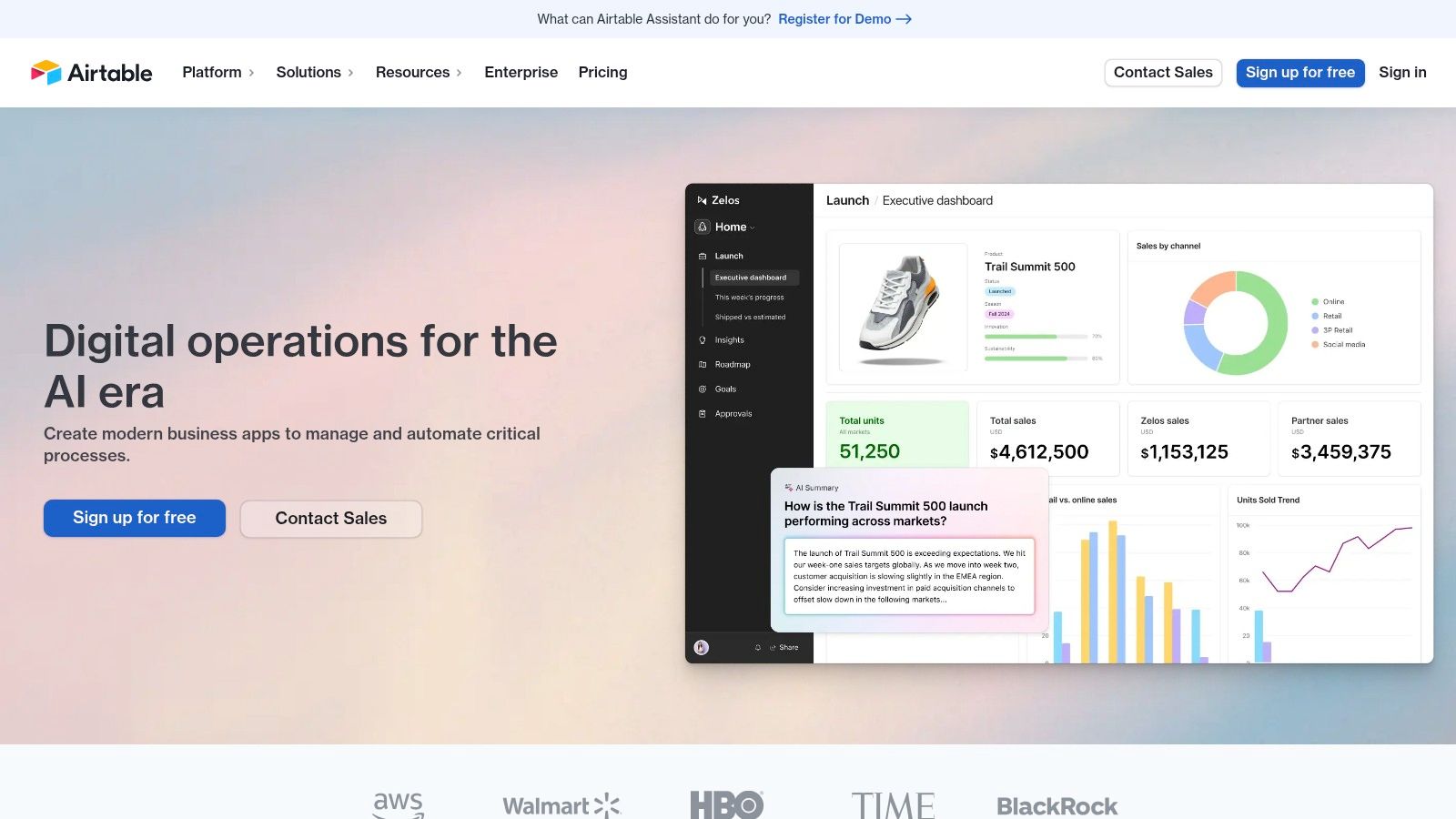
For small business owners juggling multiple content streams, Airtable offers a clear way to manage everything in one place. Digital marketers can use it to plan campaigns, track content performance, and collaborate with team members. Social media managers will appreciate the scheduling capabilities and the ability to visualize their content calendar in various views. Customer success teams can use Airtable to manage knowledge base articles and other content resources. Even creative agencies can leverage its power to manage complex content projects with multiple stakeholders.
Airtable's magic lies in its diverse range of features. Its multiple views (grid, calendar, kanban, gallery) allow you to visualize your editorial calendar in a way that best suits your needs. Imagine switching from a calendar view for scheduling to a kanban view for tracking progress, all within the same tool. Rich field types like attachments, long text, and checkboxes provide granular control over your content data. And with powerful filtering and sorting, you can quickly find the information you need. The "Blocks" feature extends Airtable's functionality even further, adding capabilities like charts, timelines, and more, making it a true powerhouse for editorial calendar management.
Features:
- Flexible database-spreadsheet hybrid interface
- Multiple views including grid, calendar, kanban, and gallery
- Rich field types including attachments, long text, and checkboxes
- Powerful filtering and sorting capabilities
- Blocks feature for extending functionality (charts, timelines, etc.)
- Robust API for custom integrations
Pros:
- Extremely customizable to fit specific content workflow needs
- Combines data organization with visual planning
- Can scale from simple to complex content operations
- Robust API for custom integrations
Cons:
- Free plan has limitations on records and attachments
- Can require initial setup time to build the right system
- May require formulas and automation knowledge for advanced use
Pricing: Airtable offers a free plan, as well as paid plans starting at $10 per user per month. The paid plans offer increased record and attachment limits, along with additional features.
Technical Requirements: Airtable is a web-based application accessible from any modern browser. They also offer mobile apps for iOS and Android.
Implementation Tips: Start with a simple base and gradually add complexity as needed. Utilize Airtable's templates to jumpstart your setup process. Explore the Universe community for inspiration and pre-built solutions for editorial calendar management.
Compared to simpler editorial calendar apps, Airtable offers unparalleled customization and scalability. While tools like Google Sheets can function as basic editorial calendars, they lack the robust features and relational database capabilities of Airtable. This makes Airtable a deserving entry on this list, particularly for teams managing complex content operations or those who anticipate significant growth. Airtable empowers you to build an editorial calendar that’s truly your own, evolving with your needs and driving content success. Visit the Airtable website to learn more and explore its potential for your editorial calendar.
5. Monday.com: Visual Collaboration for Content Planning
Monday.com isn't strictly an editorial calendar app, but rather a versatile Work OS adaptable for managing content workflows. Its strength lies in its highly visual and customizable interface, making it a great option for teams who thrive on clear visual organization and collaboration. Imagine effortlessly tracking your blog posts, social media updates, email campaigns, and video productions all within a single, unified platform. This adaptability is what earns Monday.com a spot on this list of top editorial calendar apps. From ideation and drafting to review, approval, and publication, Monday.com lets you map out your entire content lifecycle, ensuring everyone is on the same page and projects stay on track.
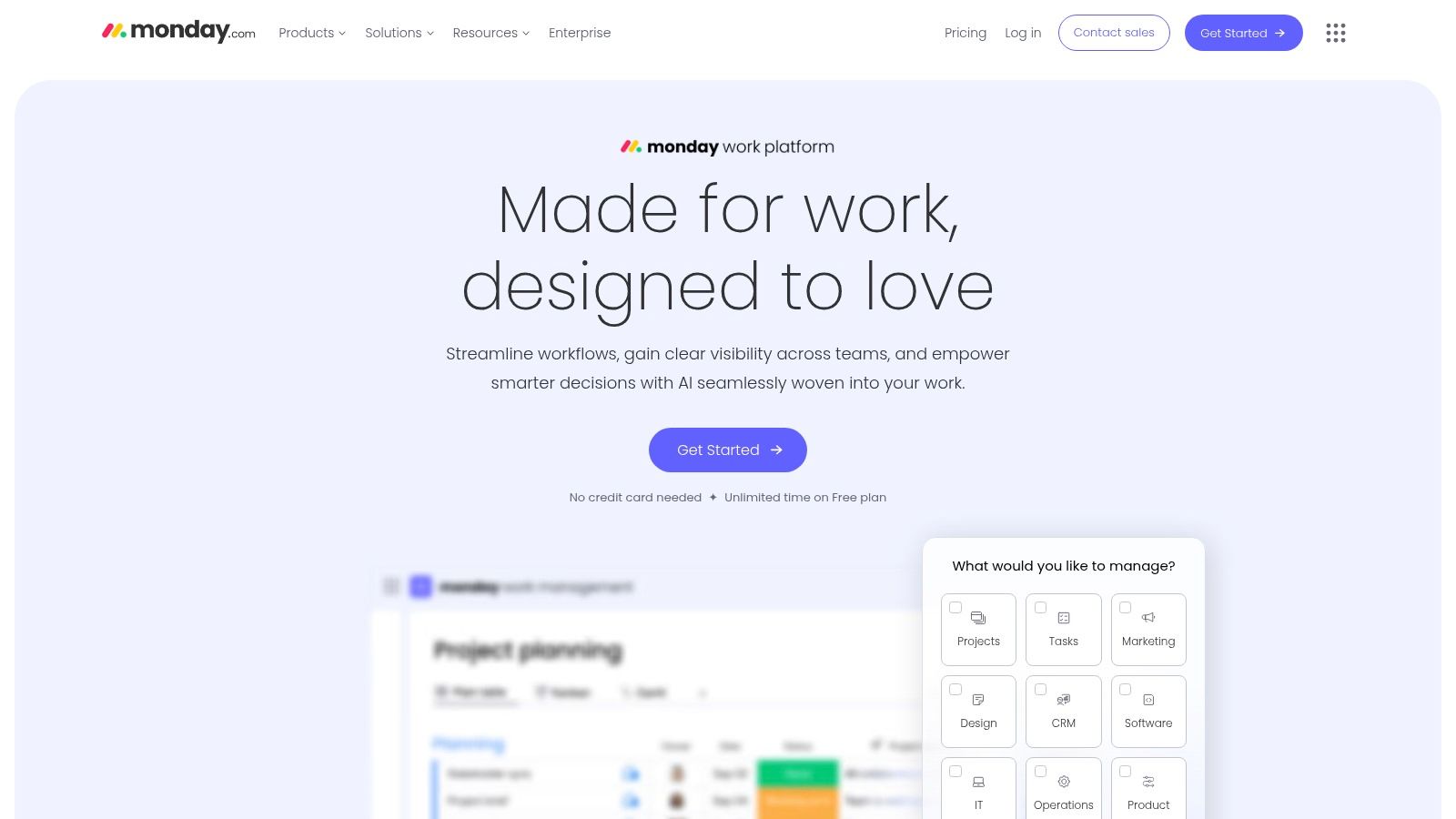
For small business owners juggling multiple marketing channels, Monday.com provides a centralized hub for managing everything. Digital marketers can utilize the platform's robust analytics dashboard to track content performance and identify areas for improvement. Social media managers can schedule posts and monitor engagement, while customer success teams can leverage Monday.com to create and manage help articles and other customer-facing content. Creative agencies can manage complex client projects with transparent workflows and clear communication, ensuring deadlines are met and feedback is incorporated effectively.
Features like customizable status indicators (think "In Progress," "Needs Review," "Published") give you a real-time snapshot of each piece of content’s progress. Multiple board views—calendar, timeline, kanban—cater to different working styles and project requirements. Need to automate recurring tasks like sending reminders or updating statuses? Monday.com’s automation recipes make this easy. The platform also excels in team collaboration, offering built-in features for updates, file sharing, and communication, all within the context of the content calendar.
Key Features:
- Visual workflows with customizable status indicators
- Multiple board views (calendar, timeline, kanban)
- Automation recipes for streamlining repetitive tasks
- Dashboard for content analytics and performance tracking
- Team collaboration with updates and file sharing
- Extensive template library, including editorial calendar templates
- Good integrations with other tools
Pros:
- Highly visual interface with color-coding for status tracking
- Intuitive and user-friendly design
- Excellent for collaboration and communication
- Highly customizable workflows
Cons:
- No free tier (free trial available)
- Can become expensive for larger teams
- Mobile app functionality is somewhat limited compared to the desktop version
Pricing: Monday.com offers tiered pricing based on the number of users and features required. Check their website for the most up-to-date pricing information.
Technical Requirements: Accessible via web browser and mobile apps (iOS and Android).
Implementation Tips:
- Start with a pre-built editorial calendar template and customize it to your specific needs.
- Utilize color-coding for content categories or status indicators to enhance visual clarity.
- Explore the automation recipes to streamline repetitive tasks and save time.
- Integrate with other tools in your marketing stack for a seamless workflow.
Comparison: While tools like Trello or Asana offer similar project management functionalities, Monday.com stands out with its focus on visual workflows and its rich feature set specifically tailored for marketing and content teams. If your team thrives on visual organization and requires a highly customizable platform, Monday.com is worth considering.
Website: https://monday.com/
6. Notion
Notion has gained popularity as an all-in-one workspace, and its flexible nature makes it a powerful, albeit complex, option for creating and managing an editorial calendar. More than just a simple calendar app, Notion allows content teams to combine content planning, creation, and knowledge management all within a single platform. This makes it particularly appealing to teams who value having all their project information centralized and easily accessible. Instead of jumping between a calendar tool, a document editor, and a communication platform, everything can live and breathe within Notion.
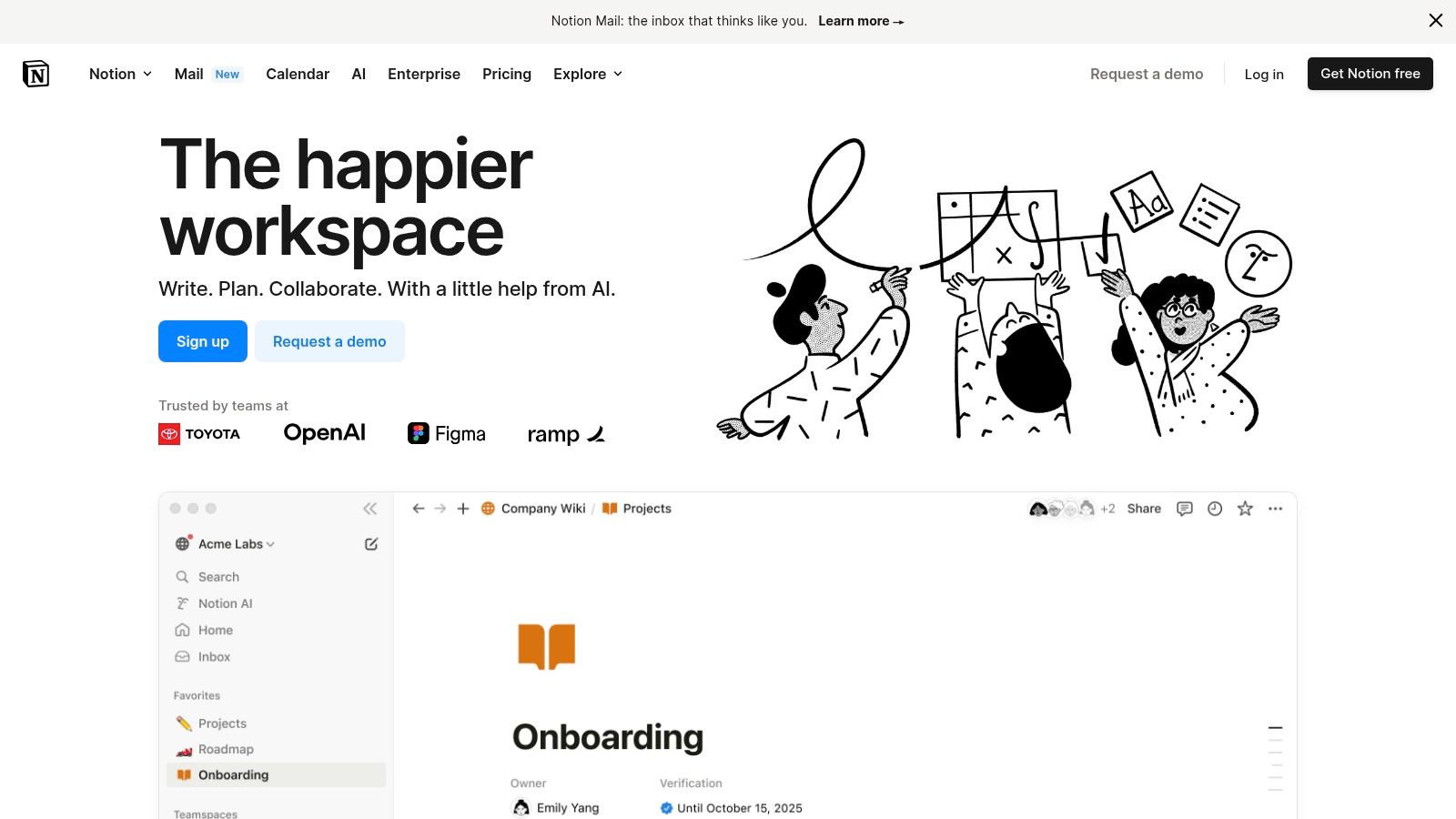
Notion's strength lies in its highly adaptable database system. You can visualize your editorial calendar in multiple views, including a traditional calendar view, a Kanban-style board view for managing workflow, a list view, and more. This flexibility allows you to tailor the calendar to your specific needs and preferences. For example, a social media manager might prefer the calendar view for scheduling posts, while a content writer might find the board view more useful for tracking the progress of articles through different stages (drafting, editing, publishing).
Rich text editing capabilities mean you can create content directly within Notion, eliminating the need to switch between different applications. This streamlines the content creation process and keeps everything neatly organized within your editorial calendar. Imagine drafting a blog post outline within the same platform where you scheduled its publication – that’s the power of Notion. The page hierarchy system helps structure your content plans and documentation, making it easy to find what you need. You can create parent pages for different content categories (blog, social media, email) and then create child pages for individual content pieces.
Notion offers a generous free tier suitable for individuals and small teams getting started with editorial calendar apps. Paid plans unlock additional features like increased file uploads, collaboration tools, and version history. While Notion doesn't publicly list technical requirements, it's a web-based application accessible from any modern browser and also has desktop and mobile apps, making it platform-agnostic.
Key Features of Notion as an Editorial Calendar App:
- Flexible Database System: Multiple views (calendar, board, list, etc.) for customized workflows.
- Rich Text Editing: Create and edit content directly within the platform.
- Page Hierarchy: Organize content plans and related documentation effectively.
- Templates: Jumpstart your setup with pre-built editorial calendar templates.
- Web Clipper: Save content ideas and research from the web directly into Notion.
Pros:
- All-in-one platform: Combines planning, content creation, and knowledge management.
- Highly customizable: Adapts to various workflows and team structures.
- Good free tier: Accessible for individuals and small teams.
- Strong knowledge management: Centralized repository for all project-related information.
Cons:
- Learning curve: Requires time and effort to master its full potential.
- Can be slower: Performance can lag, especially with large databases.
- Limited automation: Fewer automation features compared to dedicated marketing automation tools.
Implementation Tips:
- Start with a template: Leverage pre-built editorial calendar templates to get started quickly.
- Define your workflow: Clearly outline your content creation process and customize Notion to match.
- Utilize the different views: Experiment with different views (calendar, board, list) to find what works best for your team.
- Integrate with other tools: While Notion offers a lot, consider integrations with other tools to enhance functionality (e.g., Zapier for automation).
Compared to dedicated editorial calendar apps like CoSchedule or Monday.com, Notion offers greater flexibility and customization but sacrifices some ease of use and specific marketing features. It’s an excellent choice for teams who prioritize a centralized workspace and value the ability to mold the tool to their exact needs. If you're willing to invest the time to learn its intricacies, Notion can become a powerful hub for all your editorial planning and content creation activities.
7. ContentCal (now Bynder)
ContentCal, recently acquired by Bynder, earns its spot on this list of top editorial calendar apps for its purpose-built design focused on streamlining content creation and social media management. While it's undergoing some platform changes as it integrates with Bynder, it remains a powerful tool for planning, collaborating, and publishing content, particularly for social media-focused teams. If you're searching for editorial calendar apps to organize your content strategy, ContentCal is worth considering.
ContentCal's core strength lies in its visual content calendar, presented in a user-friendly interface with drag-and-drop functionality. This makes it easy to schedule posts, visualize your content plan, and manage campaigns across various social media channels. Color-coding options allow you to categorize content by channel or content type, providing a clear overview of your planned output. Imagine easily dragging and dropping a planned Instagram post to a different day or quickly identifying all your blog posts scheduled for the month thanks to intuitive color-coding. This visual approach simplifies complex content schedules, making ContentCal ideal for visual planners.
Beyond scheduling, ContentCal shines in its collaborative features. Teams can work together on content creation, provide feedback within the platform, and manage approval workflows, ensuring everyone is on the same page. This is invaluable for agencies, marketing teams, and businesses collaborating on content. The built-in content hub serves as a centralized repository for storing and repurposing content ideas, promoting consistency and efficiency.
For social media managers, ContentCal offers direct publishing and analytics integration. You can schedule posts across various platforms and track their performance, providing data-driven insights to optimize your social media strategy. This direct integration removes the need for separate social media scheduling tools, further streamlining your workflow.
Features:
- Visual content calendar with color-coding by channel or content type
- Approval workflows for content review processes
- Content hub for storing and repurposing content ideas
- Social media publishing and analytics
- Collaboration tools for team planning and feedback
Pros:
- Purpose-built for content and social media planning
- User-friendly interface with drag-and-drop functionality
- Strong collaboration features for team feedback
- Good analytics for content performance tracking
Cons:
- Now part of Bynder, undergoing platform changes, which might lead to some initial adjustments for existing users.
- Some users report limitations with certain social media integrations. Be sure to check if your required platforms are fully supported.
- Higher pricing tiers are needed for larger teams or advanced features.
Pricing: Pricing details aren't readily available on the Bynder website and may depend on the overall Bynder suite you choose. It's best to contact Bynder directly for up-to-date pricing information.
Technical Requirements: ContentCal is a web-based application accessible through any modern browser. Specific requirements may apply for social media integrations.
Comparison: Compared to general-purpose editorial calendar apps, ContentCal offers a more specialized approach to social media management. Tools like Trello or Asana can be adapted for content planning, but ContentCal provides dedicated features like direct social media publishing and analytics which are highly beneficial for social media-focused teams.
Implementation Tip: Start with a free trial or demo to explore ContentCal's features and see if it fits your workflow. When setting up your calendar, utilize the color-coding and tagging features to organize your content effectively.
Website: https://www.bynder.com/en/products/contentcal/
Despite the ongoing integration with Bynder, ContentCal remains a robust option for those seeking dedicated editorial calendar apps optimized for social media management. Its visual interface, collaborative tools, and direct publishing capabilities make it a powerful asset for individuals and teams looking to streamline their content workflow.
8. ClickUp
ClickUp is more than just an editorial calendar app; it's a comprehensive productivity platform that excels at content planning and management. Its robust features, extensive customization options, and seamless integration with broader project management tools make it an ideal solution for teams looking to streamline their content workflows and centralize all their work in one place. This makes it a strong contender for businesses seeking a powerful all-in-one solution for managing their editorial calendar. From individual bloggers to large marketing agencies, ClickUp's adaptable framework can be tailored to fit a variety of content strategies. Looking to manage a complex blog rollout, schedule social media posts, or coordinate content creation across multiple channels? ClickUp provides the tools to handle it all.
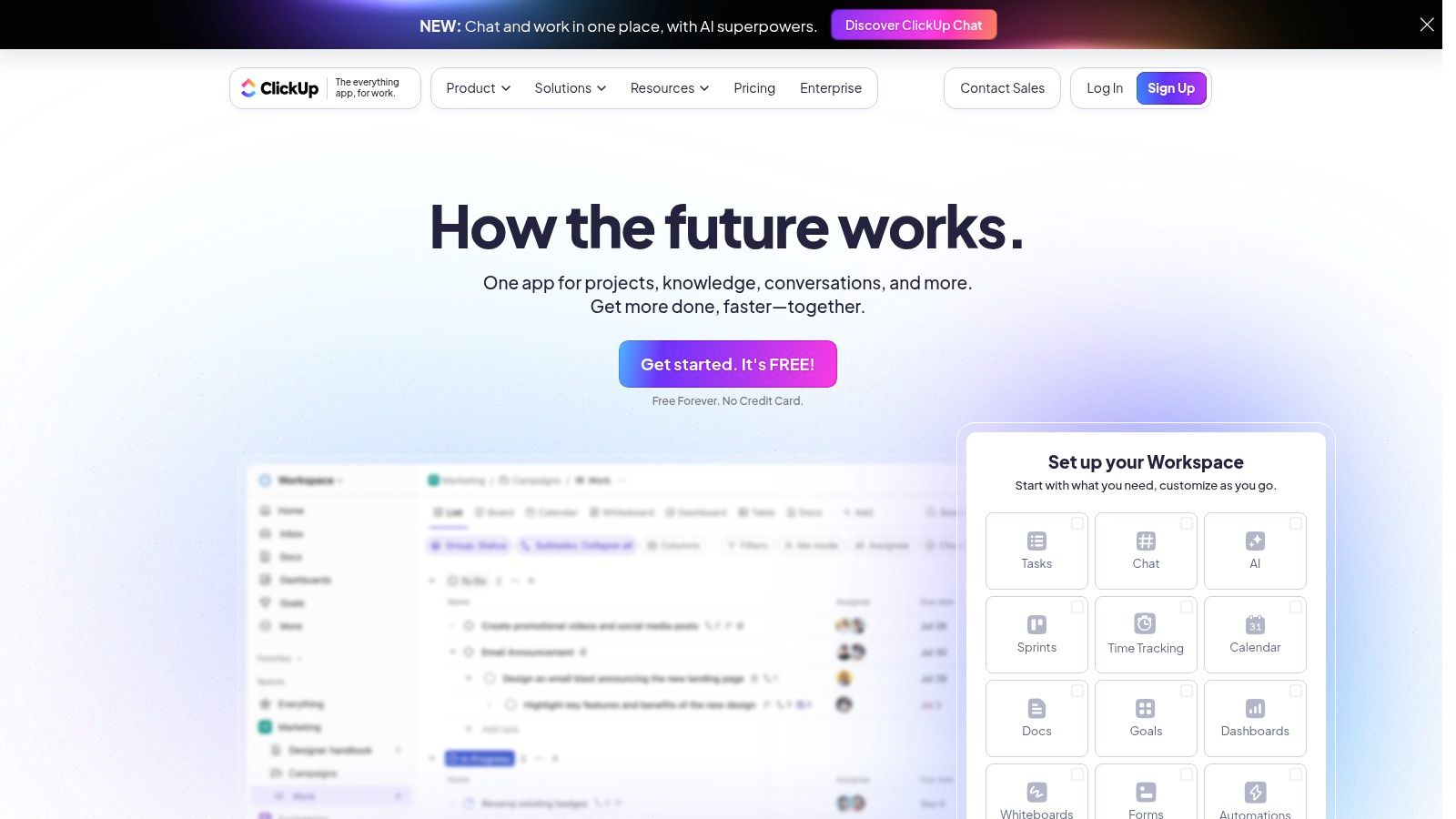
ClickUp's strength lies in its flexibility. Multiple views, including list, board, calendar, Gantt, and timeline, provide different perspectives on your content schedule. You can visualize your editorial calendar as a traditional calendar, Kanban board for agile workflows, or a Gantt chart for detailed project management. Custom statuses and fields allow you to track content progress with granular detail, ensuring every piece moves through the pipeline efficiently. For instance, you can create custom statuses like "Idea," "Drafting," "Editing," "Review," "Published," and "Promoting" to reflect your specific workflow stages. The built-in Docs feature is invaluable for creating detailed content briefs and style guidelines, maintaining consistency and clarity across your team. For data-driven content strategists, ClickUp's Goals and reporting functionality allows for meticulous performance tracking and insightful analysis. You can set goals for content output, track key performance indicators (KPIs), and generate reports to monitor progress and identify areas for improvement. Furthermore, ClickUp’s powerful automation features can streamline repetitive tasks, such as assigning tasks, updating statuses, and sending notifications.
Features:
- Multiple views (List, Board, Calendar, Gantt, Timeline)
- Custom statuses and fields
- Docs for content briefs and guidelines
- Goals and reporting
- Automation for editorial workflows
Pros:
- All-in-one platform replacing multiple tools
- Highly customizable workflows
- Generous free plan
- Regular updates and new features
Cons:
- Can be overwhelming initially
- Occasional performance issues reported by some users
- Steeper learning curve compared to simpler tools
Pricing: ClickUp offers a free plan with unlimited tasks and members, making it a great starting point for small teams. Paid plans, with additional features and storage, start at $5 per member per month.
Technical Requirements: ClickUp is a web-based application accessible on any modern browser. Mobile apps are also available for iOS and Android devices.
Implementation Tips:
- Start with a simple setup and gradually explore advanced features.
- Utilize templates to quickly create editorial calendars for different content types.
- Integrate with other tools your team uses, such as Slack or Google Drive.
- Take advantage of ClickUp’s extensive documentation and tutorials.
ClickUp competes with tools like Trello, Asana, and Monday.com, but differentiates itself with its broader scope of functionalities and highly customizable nature. While Trello excels at Kanban-style project management and Asana focuses on task management, ClickUp aims to be a central hub for all your team’s work, including editorial calendar management. This breadth of functionality can make it a more powerful, albeit more complex, solution for businesses seeking a comprehensive platform.
Website: https://clickup.com/
ClickUp's inclusion in this list is warranted by its powerful combination of features, flexibility, and value. While the sheer number of features can initially seem daunting, the platform's customizability empowers content teams to tailor it to their specific needs, making it a worthwhile investment for those willing to climb the learning curve. The generous free plan allows teams to experiment and experience the core benefits before committing to a paid subscription.
9. Buffer
Buffer earns its spot on this list of editorial calendar apps as a strong contender for those heavily focused on social media content. While not a full-fledged editorial calendar in the traditional sense, its robust social media management capabilities, including a visual content calendar, make it an invaluable tool for planning and scheduling social media posts. This makes it particularly suitable for small business owners, digital marketers, social media managers, and creative agencies whose marketing strategies prioritize social media engagement.
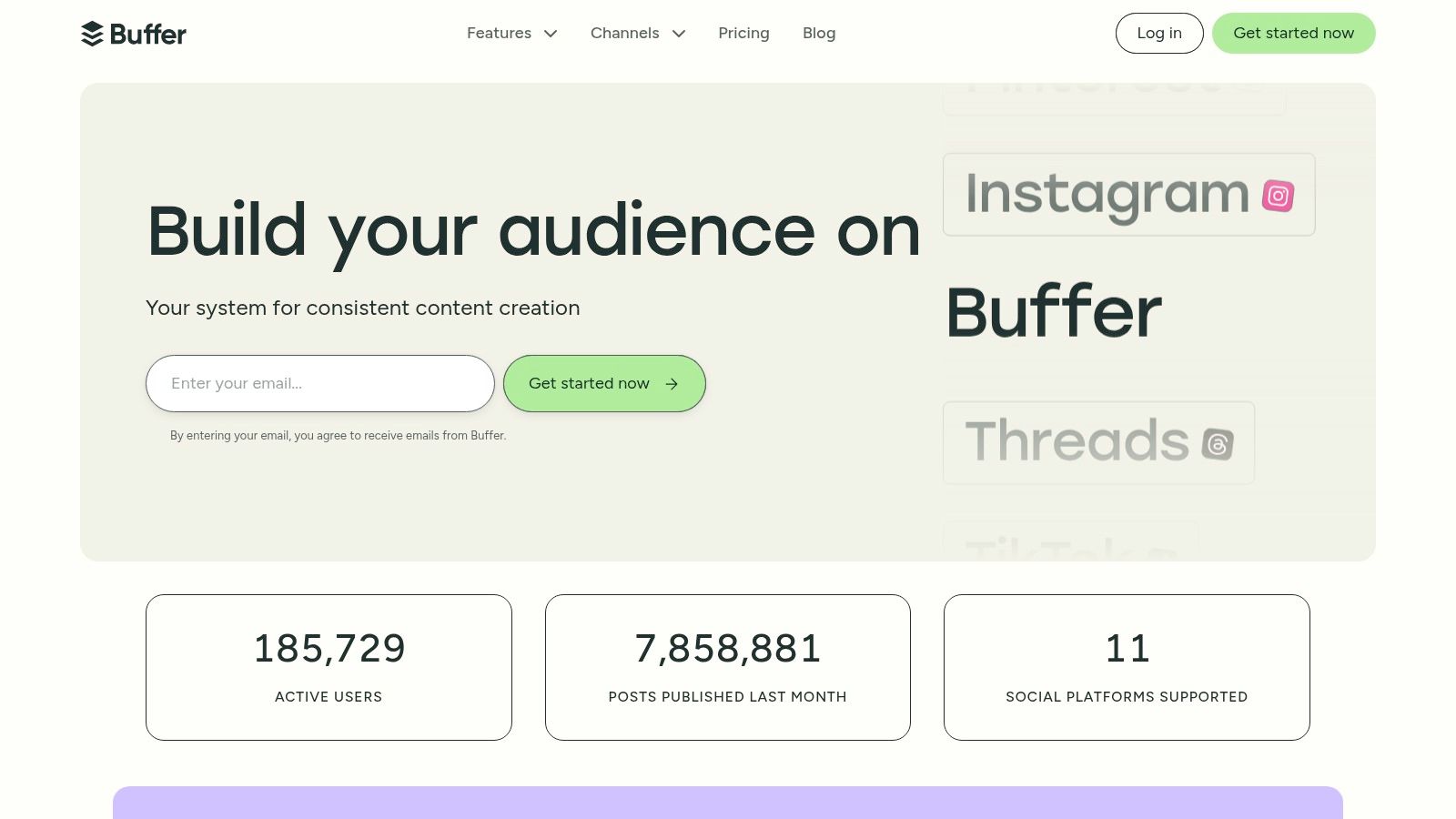
Buffer shines in its ability to streamline social media workflows. Its intuitive interface makes it easy to schedule posts across multiple platforms like Facebook, Instagram, Twitter, LinkedIn, and Pinterest. Imagine effortlessly coordinating a product launch announcement across all your social channels, complete with platform-specific formatting and optimal posting times. Buffer's visual calendar provides a clear overview of your planned content, allowing you to identify gaps and maintain a consistent posting schedule. Furthermore, features like content approval workflows and hashtag planning simplify collaboration and optimize content for better reach. You can learn more about Buffer and its social media scheduling capabilities to fully understand its power.
Buffer offers a tiered pricing structure. The free plan is a great starting point for individuals or small businesses with limited social media needs, while paid plans unlock additional features like analytics, engagement tools, and team collaboration features. Technical requirements are minimal, with access primarily through a web browser or their mobile apps for iOS and Android devices.
While Buffer excels in social media management, its focus in this area becomes a limitation when it comes to broader content planning. Unlike dedicated editorial calendar apps, Buffer offers limited functionality for managing non-social content like blog posts, email campaigns, or print materials. Therefore, if your editorial strategy encompasses a wider range of content types beyond social media, you might need to supplement Buffer with another tool. Similarly, certain advanced features, such as detailed analytics and custom reports, are reserved for higher-tier subscription plans.
Features:
- Visual calendar for social media content planning
- Multi-platform scheduling for all major social networks
- Content approval workflows
- Analytics for tracking social media performance
- Hashtag planner and first comment scheduling
Pros:
- Intuitive interface that's easy to learn
- Excellent for coordinating content across multiple social platforms
- Good mobile apps for on-the-go management
- Analytics to track content performance
Cons:
- Primarily focused on social media rather than broader content planning
- Limited functionality for non-social content types
- Some advanced features require higher-tier plans
Website: https://buffer.com/
Implementation Tip: Start with a free Buffer plan to familiarize yourself with the interface. Connect your social media accounts and experiment with scheduling posts. As your needs grow, explore the paid plans to unlock more advanced features and team collaboration capabilities. Consider integrating Buffer with other tools in your marketing stack to streamline your entire workflow.
10. Loomly
Loomly bills itself as a "brand success platform," but at its core, it offers a robust suite of features that make it a strong contender among editorial calendar apps. It's designed to help content teams manage the entire content lifecycle, from the initial brainstorming session all the way to publication and subsequent performance analysis. This makes it an excellent choice for teams who want a centralized platform to manage all aspects of their content strategy. Its structured workflows for content creation and approval are particularly useful for ensuring consistent quality and timely delivery.
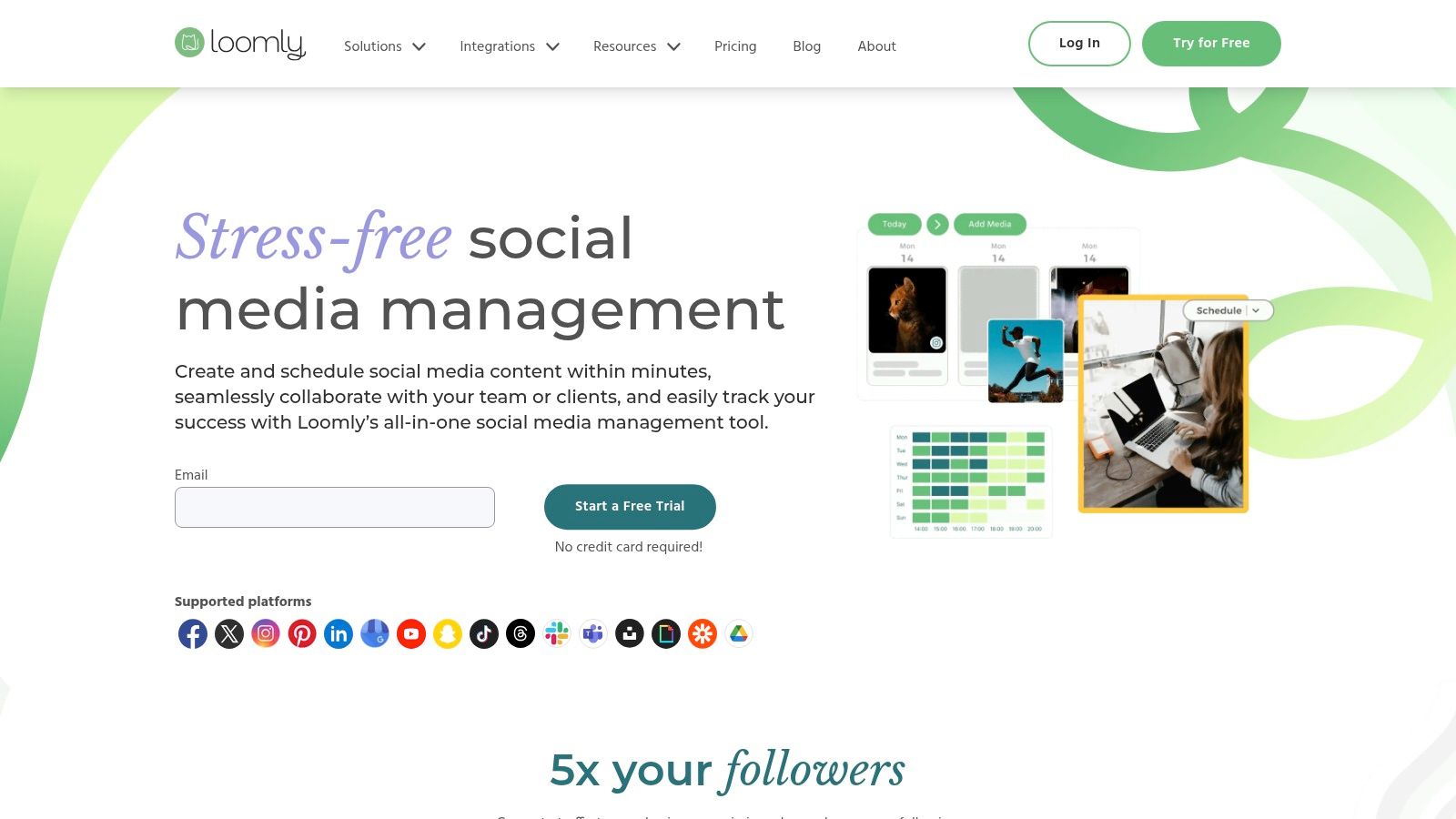
Loomly shines in its collaborative features, making it ideal for teams working together on content projects. Features like the Post Builder provide optimization tips for different platforms, streamlining the creation process. An integrated asset library helps keep all your media organized and readily accessible, while collaborative review and approval workflows ensure everyone is on the same page. Automated post scheduling and publishing further simplify the process, freeing up time for more strategic tasks. Loomly even offers content inspiration and ideas based on current trends and events, helping teams stay ahead of the curve and capitalize on relevant topics. For social media managers, this is a game-changer.
For small business owners and digital marketers, Loomly offers a centralized platform to plan and execute content strategies across various channels. Customer success teams can use Loomly to create and schedule engaging content that educates and supports their clients. Creative agencies can leverage Loomly's collaborative features to manage multiple client projects efficiently, ensuring consistent branding and timely delivery.
Features:
- Post Builder with optimization tips: Tailored advice for different social media platforms.
- Asset library: Centralized storage for all your media files.
- Collaborative review and approval workflows: Streamlined feedback and sign-off processes.
- Post scheduling and automated publishing: Set it and forget it content delivery.
- Content inspiration and ideas: Stay on top of trends and generate fresh content ideas.
- Content briefs: Ensure consistency in quality and messaging.
- Intuitive calendar interface: Easy navigation and visualization of your content plan.
Pros:
- Purpose-built for content and social media planning: Loomly's focus on content makes it a powerful tool for managing a consistent online presence.
- Content brief feature helps maintain consistent quality: This is a key differentiator, ensuring all content aligns with brand guidelines and objectives.
- Good collaborative features for team feedback: Streamlined communication and review processes.
- Intuitive calendar interface: Easy to navigate and understand, even for beginners.
Cons:
- No free plan (only free trial): While Loomly offers a free trial, ongoing use requires a paid subscription.
- More focused on social media than other content types: While Loomly can be used for other content types, its primary focus is social media management. This might be a limitation for teams focused on blog posts, email marketing, or other non-social content.
- Some users report limitations with certain integrations: While Loomly integrates with several platforms, some users have reported limitations with specific integrations. Researching compatibility with your existing tools is advisable.
Pricing: Loomly offers various pricing tiers based on the number of users and features required. Check their website for the most up-to-date pricing information.
Technical Requirements: Loomly is a web-based application accessible from any modern browser. No special software installation is required.
Implementation/Setup Tips: Start by connecting your social media accounts and importing any existing content calendars. Utilize the content brief feature to establish clear guidelines for your team. Explore the content inspiration tools to generate new ideas and stay on top of industry trends.
Comparison with Similar Tools: While tools like Hootsuite and Buffer offer similar scheduling and publishing features, Loomly differentiates itself through its emphasis on the entire content lifecycle, including ideation, collaboration, and analysis. Its content brief feature is also a significant advantage for maintaining consistent quality and brand messaging.
Why Loomly Deserves Its Place in the List: Loomly offers a comprehensive solution for managing the entire content lifecycle, especially for social media focused teams. Its collaborative features, content inspiration tools, and intuitive interface make it a powerful editorial calendar app for businesses and agencies of all sizes. While the lack of a free plan may be a deterrent for some, the robust features and streamlined workflow make Loomly a worthwhile investment for those serious about content marketing.
Website: https://www.loomly.com/
Top 10 Editorial Calendar Apps: Head-to-Head Comparison
| Platform | Core Features ✨ | User Experience ★ | Target Audience 👥 | Value Proposition 💰 |
|---|---|---|---|---|
| CoSchedule | Marketing calendar, drag-&-drop, integrations | Visual & comprehensive | Marketing teams & content creators | All-in-one marketing management |
| Trello | Kanban boards, customizable cards | Intuitive, visual, free tier | Small/medium teams, flexible workflows | Flexible project management with low barrier entry |
| Asana | Multiple views, workflow automation, custom fields | Powerful, collaborative, timeline view | Teams needing robust work management | Comprehensive project & content tracking |
| Airtable | Database-spreadsheet hybrid, grid/calendar/kanban views | Customizable & scalable | Data-driven teams & creative planners | Highly tailored content organization |
| Monday.com | Visual workflows, color-coded boards, automation recipes | User-friendly & visually appealing | Teams seeking operational customization | Streamlined content & project management |
| Notion | Flexible databases, rich text editing, page hierarchy | Versatile and all-in-one | Small teams to enterprises | Combines note-taking, docs & planning |
| ContentCal (Bynder) | Visual content calendar, approval workflows, content hub | User-friendly with strong collaboration | Content and social media teams | Optimized social & content planning |
| ClickUp | Multiple views (list, board, calendar, Gantt), custom fields | Feature-rich & highly customizable | Teams seeking all-in-one productivity | Consolidates multiple tools into one platform |
| Buffer | Social media scheduler, visual calendar, analytics | Intuitive & mobile-friendly | Social media managers | Effective multi-platform social scheduling |
| Loomly | Post builder, asset library, collaborative approval | Intuitive, content-focused interface | Marketing teams & social media planners | Structured content and social planning |
Choosing the Right Editorial Calendar App for Your Needs
Finding the perfect editorial calendar app can feel overwhelming with so many options available. This list of 10 leading platforms—from established players like CoSchedule and Trello to flexible solutions like Notion and Airtable, and social media focused tools like Buffer and Loomly—offers a solid starting point. Key takeaways to remember when choosing include considering your team's size, budget, required integrations (like social media scheduling or project management tools), and the complexity of your content strategy. Whether you need a simple drag-and-drop interface or robust customization features, there's an editorial calendar app tailored to your specific needs. Remember to leverage free trials or free tiers available in many of these apps to explore their features and functionalities before committing. Implementing the right tool can streamline your content creation process, improve team collaboration, and ultimately, elevate your content marketing efforts.
Choosing and implementing the best editorial calendar app for your needs is a crucial step in a successful content strategy. Consider factors such as your team's workflow, the platforms you publish on, and the level of detail needed for content planning. By carefully evaluating these factors alongside the insights provided in this article, you'll be well-equipped to make an informed decision and take your content management to the next level.
Ready to supercharge your content calendar with authentic social proof? Integrate your chosen editorial calendar app with EndorseFlow to seamlessly incorporate customer testimonials into your content strategy, boosting credibility and engagement. Visit EndorseFlow today to learn more.